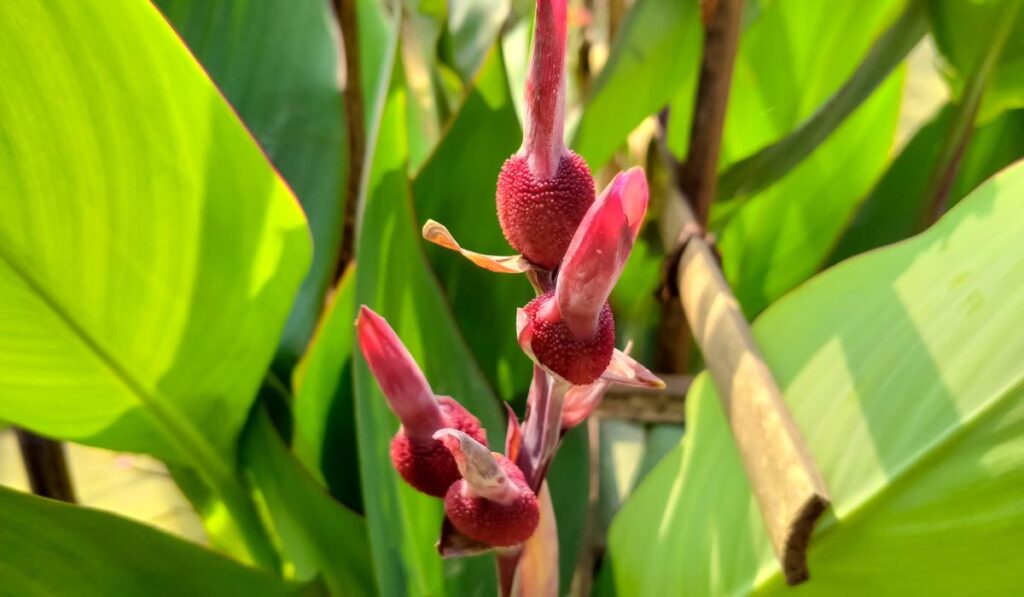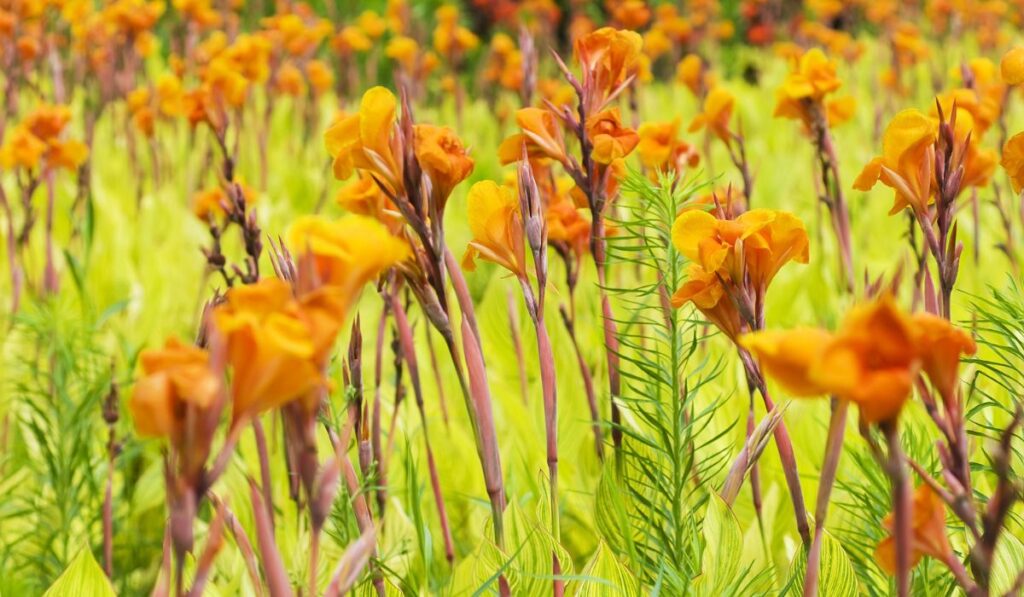Canna lilies are beautiful flowers with vibrant colors and lush blooms. However, as with many beautiful flowers, planting them requires some special knowledge, hard work, and dedication. So, when is the best time to plant canna bulbs?
The best time to plant canna bulbs is in the spring or summer since canna bulbs can’t tolerate the cold weather and need to be planted in warm soil (ideally 60 degrees Fahrenheit or higher). It’s also best not to wait until too late in the summer, since temperatures will drop soon afterward.
Let’s take a closer look at the best time to plant canna bulbs as well as how to do so correctly and what they need to survive and thrive. Doing your research is the best way to keep your plants alive and well.
Ideal Months for Planting Canna Bulbs

The best months to plant canna bulbs are April through June. This spring and early summer period means that the soil will be warm enough (above 60 degrees Fahrenheit) and that there will be enough warm months ahead for them to bloom and thrive.
However, the ideal timing is largely dependent on where you live — some hotter states may allow for canna bulbs to be planted earlier, and you may need to wait until summer for the colder states.
That said, it’s not a great idea to wait too long into the summer. Before you know it, fall will be back and the temperatures will once again be too cold for canna bulbs to survive. So, if you’ve waited too long and August is already here, you might want to wait until next year for the best results.
As an alternative, you can always plant the bulbs and then bring them immediately inside or plant them in pots from the start, especially if you’re looking to have them inside for winter anyway and really want to get your plants going.
How to Plant Canna Bulbs
First, dig a hole a couple of inches into your soil and put a soil thermometer (on Amazon) in there. That will tell you if the soil is warm enough to support the canna lilies as they bloom.
Dig a hole around three inches deep and set the canna bulbs (which you can buy on Amazon) in there. The bumps on the bulb should be pointing upwards toward the sky. They should be no less than a foot apart, though a couple of feet is much better since it will give them room to grow and spread outward as they come out of the ground.
You should then cover the bulbs with two inches of soil and give them plenty of water. After that, you’ll want to make sure you don’t give them any more water for around three weeks. Then, you can watch for signs of them popping out of the ground.
It can take around two or three months for the bulbs to fully bloom (which is why planting them in late summer usually isn’t a good idea).
Pot-Planting vs. In-Ground Planting
When it comes to planting the bulbs in pots vs. doing it in the ground, many people prefer pots because they can be brought inside for the winter. If you leave your lilies in the ground, they should come back next year since they’re perennial.
However, you can always move them to pots and bring them inside so they can keep blooming through the winter.
To move your canna bulbs to a pot, dig up the rhizome mass with great care and cut back any of the foliage to about an inch long. Each section of the plant you cut off needs to have at least one of those bulbs that were facing upwards when you planted them (known as eyes) for the flowers to bloom from it again.
You can also gently dip them into a bleach solution (one part bleach to ten parts water) to kill off any bacteria. Always be very conservative with the bleach; otherwise, you could kill the plant.
After that, you can put them in pots with soil and keep them in your house. You’ll still have to give them plenty of water, and they should be stored in a cool, dry place that doesn’t drop below 40 degrees Fahrenheit or they will certainly die.
Are Canna Lilies Easy to Take Care Of?

Although planting canna lilies and moving them inside for winter can be a bit of a hassle, they generally aren’t difficult to take care of and are on the low-maintenance side of plants when they’re in full bloom.
If you want them to continually bloom, you’ll have to make sure they get fertilizer that’s high in phosphate every month — but that’s the biggest consideration you need to think about.
You can reduce watering when the canna lilies flower, but you still need to make sure they have water and the soil doesn’t dry up, or your canna plants may die.
Which Climate Is Best for Cannas?
Cannas love hot and humid weather, making them perfect if you live in the south of the United States. They require a lot of water, so you have to be very on top of making sure they get what they need.
If you live in a particularly warm place, giving them partial shade and partial sun throughout the day is ideal. If your state is a little cooler, then try placing them in the full sun, as that’s likely where they’ll thrive the best.
Can I Grow Canna Lilies in Colder Climates?
It’s possible to grow cannas in colder climates if you get enough heat during the summer months, but you might find it to be a much harder job, and you will definitely have to pot them in the colder season.
Will My Cannas Survive the Winter?
Your cannas may survive the winter in the ground if you live in a state like Florida, Texas, or Georgia — though they won’t bloom in the winter at all. If temperatures drop too much, your canna lilies will likely die, so it’s always safest to winterize them.
Can I Keep My Canna Plants Indoors Year-Round?
Some people don’t have an outdoor space but still want to grow canna lilies, or simply prefer to keep their plants inside for decorative purposes. Canna plants can survive for many years indoors.
Follow the same planting instructions for outside but find a place inside that’s warm, where they can get lots of sun. Never move them to a place in the house that drops below 40 degrees Fahrenheit or they’ll die, and make sure to keep checking on the soil even through the winter.
Will My Cannas Attract Hummingbirds?
Many people use cannas as a way to attract hummingbirds to their house. The flowers are rich in nectar, so the little birds are very attracted to them, making them a great choice if you love to view the local wildlife in your yard.
In addition to hummingbirds, canna plants also attract bees and butterflies. This not only makes your yard look great with all of the colors butterflies can bring, but helps the bees by providing them with much-needed nectar.
Other Canna Considerations
If you’re going to bring canna plants into your yard or home, keep these other things in mind as you care for them:
Are Canna Lilies Toxic to Dogs and Cats?
Because lilies are generally toxic to our furry friends, people often assume canna lilies are too. Despite their name, however, these plants aren’t true lilies, which means there’s no risk to cats and dogs. Nonetheless, keeping the plants out of their reach is still wise.
What’s the Latest a Canna Lily Will Bloom Outside?
Although it depends on the climate, October is generally the latest time a canna lily will bloom outside. If you’re going to bring them inside for the winter, make sure you do so beforehand.
What’s the Best Way to Display Canna Lilies?
Make sure your canna plants are a couple of feet apart to give them room to bloom. As they’re very lush-looking with bright colors, they tend to look better as a focal point than as an addition.
How Much Water Do Canna Lilies Need?
You should keep the soil moist, but once they’ve flowered, you only need to water them once every few days.
Are Canna Lilies Good for Beginners?
Compared to other plants and flowers, canna lilies are great for beginners. They do take some care when planting them and moving them inside can be a little tricky for those who aren’t used to plants, but if you do your research, it’s easy to help them thrive and look great in your yard throughout the summer (or in your home all year round).
What Should I Do if My Canna Dies?
Unfortunately, if your canna dies, you’ll need to plant some new bulbs and try again. However, remember these plants are perennial, so just because they’re not blooming through the winter doesn’t mean they won’t come back — make sure they’re truly dead before you dig them up and get rid of them!
If they’re dried out and have rotted through, that means they’re surely dead. If you’re not certain, ask someone who knows better or plant them anyways and wait it out. If 10-12 weeks have passed and your bulbs aren’t sprouting into flowers, then they’re likely dead.
